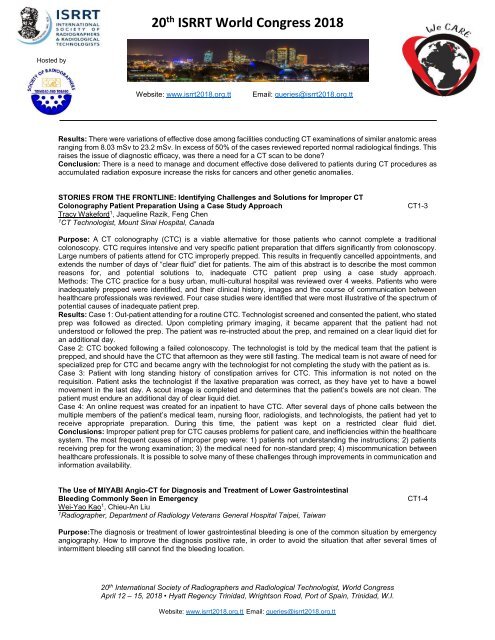Trinidad-and-Tabago-Congerss-Abstract-Book
You also want an ePaper? Increase the reach of your titles
YUMPU automatically turns print PDFs into web optimized ePapers that Google loves.
20 th ISRRT World Congress 2018<br />
Hosted by<br />
Website: www.isrrt2018.org.tt<br />
Email: queries@isrrt2018.org.tt<br />
Results: There were variations of effective dose among facilities conducting CT examinations of similar anatomic areas<br />
ranging from 8.03 mSv to 23.2 mSv. In excess of 50% of the cases reviewed reported normal radiological findings. This<br />
raises the issue of diagnostic efficacy, was there a need for a CT scan to be done?<br />
Conclusion: There is a need to manage <strong>and</strong> document effective dose delivered to patients during CT procedures as<br />
accumulated radiation exposure increase the risks for cancers <strong>and</strong> other genetic anomalies.<br />
STORIES FROM THE FRONTLINE: Identifying Challenges <strong>and</strong> Solutions for Improper CT<br />
Colonography Patient Preparation Using a Case Study Approach<br />
Tracy Wakeford 1 , Jaqueline Razik, Feng Chen<br />
1 CT Technologist, Mount Sinai Hospital, Canada<br />
CT1-3<br />
Purpose: A CT colonography (CTC) is a viable alternative for those patients who cannot complete a traditional<br />
colonoscopy. CTC requires intensive <strong>and</strong> very specific patient preparation that differs significantly from colonoscopy.<br />
Large numbers of patients attend for CTC improperly prepped. This results in frequently cancelled appointments, <strong>and</strong><br />
extends the number of days of “clear fluid” diet for patients. The aim of this abstract is to describe the most common<br />
reasons for, <strong>and</strong> potential solutions to, inadequate CTC patient prep using a case study approach.<br />
Methods: The CTC practice for a busy urban, multi-cultural hospital was reviewed over 4 weeks. Patients who were<br />
inadequately prepped were identified, <strong>and</strong> their clinical history, images <strong>and</strong> the course of communication between<br />
healthcare professionals was reviewed. Four case studies were identified that were most illustrative of the spectrum of<br />
potential causes of inadequate patient prep.<br />
Results: Case 1: Out-patient attending for a routine CTC. Technologist screened <strong>and</strong> consented the patient, who stated<br />
prep was followed as directed. Upon completing primary imaging, it became apparent that the patient had not<br />
understood or followed the prep. The patient was re-instructed about the prep, <strong>and</strong> remained on a clear liquid diet for<br />
an additional day.<br />
Case 2: CTC booked following a failed colonoscopy. The technologist is told by the medical team that the patient is<br />
prepped, <strong>and</strong> should have the CTC that afternoon as they were still fasting. The medical team is not aware of need for<br />
specialized prep for CTC <strong>and</strong> became angry with the technologist for not completing the study with the patient as is.<br />
Case 3: Patient with long st<strong>and</strong>ing history of constipation arrives for CTC. This information is not noted on the<br />
requisition. Patient asks the technologist if the laxative preparation was correct, as they have yet to have a bowel<br />
movement in the last day. A scout image is completed <strong>and</strong> determines that the patient’s bowels are not clean. The<br />
patient must endure an additional day of clear liquid diet.<br />
Case 4: An online request was created for an inpatient to have CTC. After several days of phone calls between the<br />
multiple members of the patient’s medical team, nursing floor, radiologists, <strong>and</strong> technologists, the patient had yet to<br />
receive appropriate preparation. During this time, the patient was kept on a restricted clear fluid diet.<br />
Conclusions: Improper patient prep for CTC causes problems for patient care, <strong>and</strong> inefficiencies within the healthcare<br />
system. The most frequent causes of improper prep were: 1) patients not underst<strong>and</strong>ing the instructions; 2) patients<br />
receiving prep for the wrong examination; 3) the medical need for non-st<strong>and</strong>ard prep; 4) miscommunication between<br />
healthcare professionals. It is possible to solve many of these challenges through improvements in communication <strong>and</strong><br />
information availability.<br />
The Use of MIYABI Angio-CT for Diagnosis <strong>and</strong> Treatment of Lower Gastrointestinal<br />
Bleeding Commonly Seen in Emergency<br />
Wei-Yao Kao 1 , Chieu-An Liu<br />
1 Radiographer, Department of Radiology Veterans General Hospital Taipei, Taiwan<br />
CT1-4<br />
Purpose:The diagnosis or treatment of lower gastrointestinal bleeding is one of the common situation by emergency<br />
angiography. How to improve the diagnosis positive rate, in order to avoid the situation that after several times of<br />
intermittent bleeding still cannot find the bleeding location.<br />
20 th International Society of Radiographers <strong>and</strong> Radiological Technologist, World Congress<br />
April 12 – 15, 2018 • Hyatt Regency <strong>Trinidad</strong>, Wrightson Road, Port of Spain, <strong>Trinidad</strong>, W.I.<br />
Website: www.isrrt2018.org.tt Email: queries@isrrt2018.org.tt


















